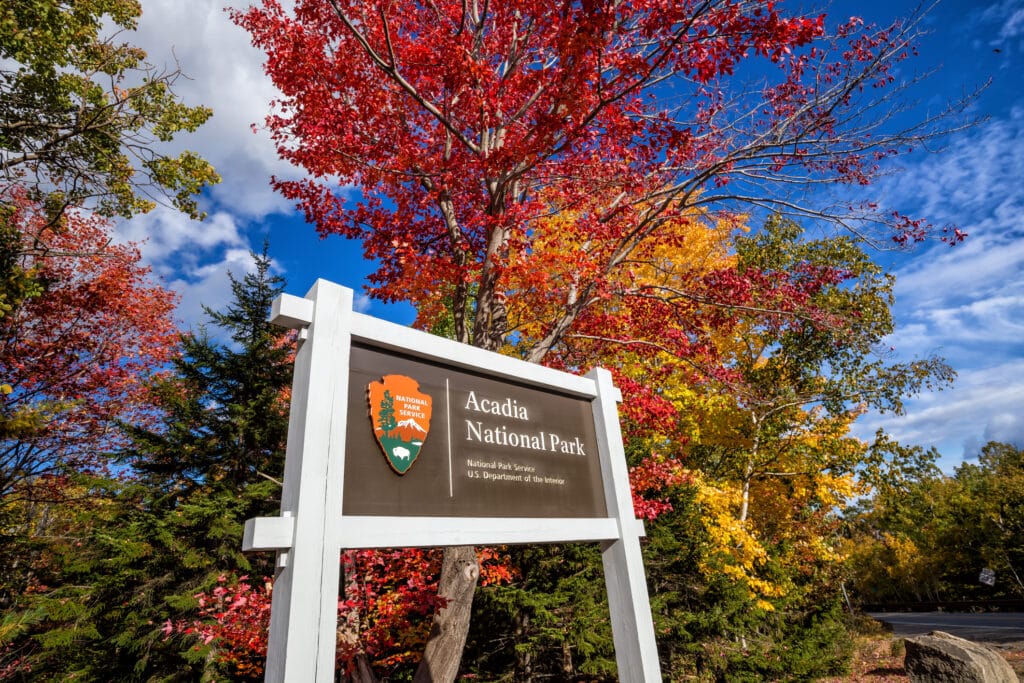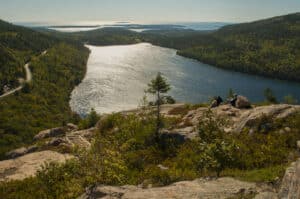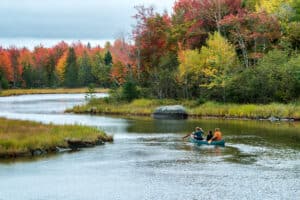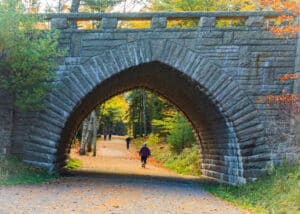
Acadia National Park requires an entrance pass for all its entrances, and it has a straightforward fee system. As of 2025, the standard 7-day entrance fee is $35 per vehicle, which covers everyone in a private car. Motorcyclists pay $30 per motorcycle (valid for two riders), and individuals arriving on foot or bicycle pay $20 per person (visitors 15 years and younger are free).
If you plan to visit multiple times, an Acadia Annual Pass is available for $70, granting unlimited entry for one year. The interagency America the Beautiful annual pass (also accepted here) costs $80 and covers Acadia along with all other U.S. national parks. Several groups qualify for free or discounted passes as well: U.S. seniors (age 62+) can obtain a lifetime senior pass for $80 (or $20 for an annual senior pass), and U.S. military members, veterans, and 4th grade students’ families are eligible for free national park passes. Do note that Acadia has switched to cashless fee payments, so have a credit/debit card ready or buy your pass online in advance.
The park itself is open year-round (24/7), but operating hours for visitor facilities and roads vary by season. During the main summer season (roughly May through October), major entrances and visitor centers—such as the Hulls Cove Visitor Center on Mount Desert Island—are staffed daily, generally from around 8:30 am to 4:30 pm.
Park Overview & Highlights
Acadia protects a remarkable slice of coastal Maine where forested mountains meet the sea. The park encompasses nearly 50,000 acres of varied terrain spread across Mount Desert Island (where most of the park lies), the Schoodic Peninsula on the mainland, and several smaller islands. It was established in the early 20th century through a pioneering conservation effort: in 1916 President Woodrow Wilson first declared it Sieur de Monts National Monument, and a few years later (1919) it became Lafayette National Park – the first national park east of the Mississippi River.
The name was changed to Acadia National Park in 1929. We were fascinated to learn that private citizens played a huge role in Acadia’s creation – philanthropist John D. Rockefeller Jr. built the park’s beautiful carriage road system, and others like George B. Dorr (often called the “father” of Acadia) worked tirelessly to secure the lands for public use. Thanks to these efforts, today’s visitors can enjoy 45 miles of historic carriage roads (closed to cars) and stone bridges that wind through the woods. The land here has a rich human history stretching back much further too – the Wabanaki people have lived in these coastal lands for thousands of years, and the park continues to collaborate with Wabanaki tribes to honor and interpret this cultural heritage.

View Of Jordan Pond In Acadia National Park In Maine.
What makes Acadia’s landscape so distinctive? Geology, for one. The park’s rounded granite peaks and ridges were sculpted by ice-age glaciers. Cadillac Mountain, Acadia’s tallest point at 1,530 feet (466 m), is composed of pink granite and was carved by glacial ice – it’s actually one of the first places in the United States to see the sunrise each day. As glaciers retreated, they also left behind clear lakes like Jordan Pond and Eagle Lake, and they gouged out Somes Sound, a narrow inlet often called the only fjord on the U.S. East Coast. The result is an array of ecosystems packed into a small area. Within a short drive or hike, we experienced wave-pounded coastal cliffs and sheltered coves, tranquil spruce-fir forests, marshy wetlands, and bare rock summits dotted with fragile alpine plants. The biodiversity here surprised us – tide pools along the shore teem with sea stars and crabs, while inland forests are home to animals like red foxes, white-tailed deer, beavers, and porcupines. Occasionally, a moose might wander through or a black bear might be spotted (though both are rare on the island). Bird life is especially rich: we saw osprey and herons near the ponds, and overhead we even spotted peregrine falcons and bald eagles soaring – these majestic birds had vanished from the area decades ago due to DDT and habitat loss but have made a strong comeback under the park’s protection.

Kayakers paddling on northeast creek Acadia National Park
Outdoor activities abound, and hiking is one of the biggest draws. Acadia contains more than 150 miles of hiking trails, ranging from gentle lakeside walks to challenging mountain climbs. We tackled a mix of trails during our visit. One morning we braved the famous Precipice Trail, carefully climbing its iron rungs and ladders up the cliff face of Champlain Mountain – it was thrilling (and a bit nerve-wracking) but the views were worth it. On another day, we opted for the Ocean Path, a much easier shoreline walk, where we enjoyed a leisurely stroll along rock ledges from Sand Beach to Otter Cliffs, admiring the crashing Atlantic waves. For a moderate hike, we loved the Jordan Pond Path, a loop around a crystal-clear pond with the Bubble Mountains reflecting in the water; part of this trail includes a rustic boardwalk through the woods.
We also walked up South Bubble mountain to see Bubble Rock, a famous glacial erratic boulder perched improbably on the cliff’s edge – it’s the kind of odd natural feature that makes you wonder: how did that rock get there? Cycling is another popular way to explore: one sunny afternoon we rented bicycles and rode a portion of the carriage roads around Eagle Lake. With motor vehicles prohibited, the carriage paths were peaceful and we could hear birds and the wind in the trees as we pedaled along gravel lanes crossing charming stone bridges. Whether you prefer hiking or biking or just sightseeing by car, Acadia offers something for everyone. In our experience, a typical visit to see the major highlights takes at least two to three days (the average stay is around 3–4 days). We spent four full days and still had plenty left undone – it’s kinda amazing how much there is packed into this park!
Behind the beautiful scenery, Acadia faces the same challenges as many busy national parks, and we gained a new appreciation for the park’s conservation efforts. Over 4 million people now visit each year (the park hit a record 4.07 million visits in 2021), which means popular spots can get very crowded. To protect fragile environments and ensure a good experience, park managers have taken steps like requiring the vehicle reservation for Cadillac Mountain visits in peak season (to prevent overcrowding at sunrise).

Historic stone bridge on carriage road in Acadia National Park, Maine, USA
There are also ongoing projects to restore and maintain trails, manage parking congestion, and reduce erosion on heavily used paths. We learned that Acadia’s staff and volunteers actively work to preserve the ecosystem – for example, they have restored native plant life on summit areas trampled by decades of foot traffic, and they monitor rare species (such as the Harlequin duck that winters along Acadia’s shores). Interestingly, a historic wildfire in 1947 burned a large portion of Mount Desert Island, and many of the hardwood forests we see today (birch, aspen, maple) grew in after that fire. In response, the park developed a fire management plan and occasionally conducts controlled burns to maintain healthy habitats and prevent excessive wildfire fuel buildup. It’s clear that Acadia is not just a pretty place to visit, but also a carefully managed natural treasure – a result of dedication by conservationists past and present.
Surrounding Attractions & Dining Choices
We didn’t limit ourselves to just one or two spots – Acadia and its surrounding communities offered a variety of memorable experiences. Here are some of the highlights we enjoyed in and around the park during our trip:
-
Cadillac Mountain Summit – We drove up to the summit of Cadillac Mountain before dawn and were treated to a spectacular sunrise panorama. At certain times of year, this is the first place in the U.S. to see the sunrise, and we felt lucky to watch the sky brighten in pink and orange hues over the Atlantic and the Porcupine Islands. (It was chilly pre-dawn, but the view was well worth the wind on the summit!) Parking is limited, so we had reserved our spot in advance for the early morning drive.
-
Jordan Pond & Bubble Rock – One afternoon we hiked a easy trail along the shore of Jordan Pond and then up a short spur to South Bubble. At the top, we found Bubble Rock – a huge rounded boulder balancing on the edge of a cliff, left there by glaciers long ago. The vantage point overlooked the blue pond and surrounding green hills; it was beautiful. After the hike, we stopped by the famous Jordan Pond House (right by the pond) for tea and popovers. The warm popover pastries with butter and strawberry jam have been a tradition here for decades, and we have to say, it was a perfect post-hike treat.
-
Thunder Hole & Ocean Path – We timed a visit to Thunder Hole, a shoreline inlet, around mid-tide and were rewarded with the spectacle of waves crashing into the rocks, making a thunderous boom and a splash of salty spray. Along the adjacent Ocean Path, we walked a scenic stretch with the sea on one side and cliffs on the other. We passed by Sand Beach (a rare sandy beach nestled between rocky shores) and continued to Otter Cliffs, taking plenty of photos. This coastal walk was easy and popular – we passed many other visitors – but it offered fantastic views of Acadia’s rugged coastline.
-
Bass Harbor Head Lighthouse – Just before sunset one evening, we drove to the southwest tip of Mount Desert Island to see this postcard-famous lighthouse. A short trail and stairway led us to a viewpoint on the rocks. We watched as the white Bass Harbor Head Light stood steadfast atop the granite shoreline, its beacon starting to glow as daylight faded. There were a few other sightseers, but it was quieter than the busier east side of the park. Watching the sun go down behind the lighthouse, with the ocean stretching out, was a peaceful way to end the day.
-
Biking the Schoodic Peninsula – Wondering how to escape the summer crowds? We found the answer by taking a day trip to Acadia’s Schoodic Peninsula section. This is a part of the park on the mainland, about an hour’s drive from Bar Harbor, and it’s far less visited. We brought our bikes and rode the one-way loop road around Schoodic Point. The road hugged a gorgeous rocky shoreline with views of the ocean and distant Cadillac Mountain across the bay. There were very few cars and at times it felt like we had the entire peninsula to ourselves. We stopped at Schoodic Point where waves were pounding the granite ledges, and we enjoyed a picnic lunch in blissful quiet. It was a striking contrast to the busier Mount Desert Island spots – an experience we highly recomend if you have extra time.
-
Bar Harbor – Each evening, we ventured into Bar Harbor, the charming town just outside the park’s main entrance. The town was lively after a day of hiking. One night we dined at Geddy’s, a local seafood restaurant, and enjoyed fresh lobster rolls and creamy clam chowder with a view of the harbor. On another night, we treated ourselves to wild Maine blueberry ice cream at a small downtown shop – a sweet taste of the region’s famous blueberries. Bar Harbor had plenty of options for relaxing: we browsed a bookstore and a shop selling Maine crafts and souvenirs, and even popped into a cozy bakery one morning for coffee and blueberry muffins. It was nice to unwind in town after days spent on the trails. The friendly, laid-back atmosphere (and the delicious seafood) made Bar Harbor a highlight in its own right.
Our visit to Acadia National Park blended adventure and relaxation in the best ways. Each day brought a new discovery – a sunrise from a mountaintop, an afternoon by a calm lake, an evening feast of lobster by the docks. We also found that starting early in the day had its perks – dawn hikes let us enjoy serene, empty trails (and even spot wildlife like deer or foxes) before the crowds awoke. We came for the scenery but left appreciating the park’s rich history and the efforts that keep it pristine. Acadia truly is a place where the mountains meet the sea, and every turn offered something special to explore. We’re already dreaming of our next trip back to this New England gem!
In the winter off-season (November through April), Hulls Cove closes, but the park headquarters (on Route 233 near Bar Harbor) is open on weekdays from 8 am to 4 pm to provide visitor information. Park Loop Road, the 27-mile scenic drive around the island’s east side, is open spring through fall but closes to vehicles each winter (from December 1 until April 14, weather permitting). Only a couple of short sections of that road remain plowed and open year-round for limited access. Similarly, the park’s unpaved roads close in late fall and reopen in mid-spring. Some walking trails occasionally close in spring (for example, sections of cliffside trails close late winter to early spring to protect nesting peregrine falcons). Despite these seasonal closures, you can still explore the park in winter by foot, snowshoe, or cross-country ski. Also, from late May through mid-October, Cadillac Mountain Summit Road requires a special $6 vehicle reservation (per car) if you plan to drive up for sunrise or other peak times; this timed-entry system helps prevent dawn traffic jams at Acadia’s most popular viewpoint. We visited on 19 July 2025, and all figures were valid then.
Sorry, there were no items that matched your criteria.

